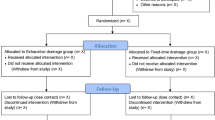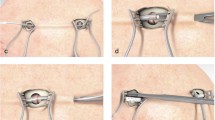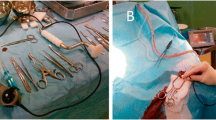Abstract
Background
Chronic subdural haematoma (cSDH) is a frequent pathology in neurosurgery. Surgical treatment varies widely and is often characterised by repeated decompression. Therapeutic efficacy was evaluated by clinical symptom relief and haematoma reduction on preoperative and postoperative CT scans.
Methods
We investigated a consecutive series of 320 cases of cSDH between 2006 and 2010. In this series, the first- and second-line treatments were performed via hollow-screw placement under local anaesthesia, whereas enlarged burr holes under general anaesthesia were used as third-line treatment.
Results
In general, 63.3% of cases were sufficiently treated by a single operation, while 16.2% needed a second procedure with hollow screws. Only 20.5% needed open surgery by an enlarged burr hole with membranectomy under general anaesthesia. After the first operation, initial symptoms improved in 80.3% of cases, remained unchanged in 15.5% and worsened in 4.2% of cases. Mean age was 74.6 ± 12.1 years, with only one case of severe surgery-related complication.
Conclusions
Initial placement of hollow screws under local anaesthesia is a safe and sufficient treatment in most cases, and should be favoured as first-line treatment in patients with cSDH, since these patients are often of older age and present with distinct comorbidity.




Similar content being viewed by others
References
Aoki N (1984) Subdural tapping and irrigation for the treatment of chronic subdural hematoma in adults. Neurosurgery 14:545–548
Bender MB, Christoff N (1974) Nonsurgical treatment of subdural hematomas. Arch Neurol 31:73–79
Camel M, Grubb RL Jr (1986) Treatment of chronic subdural hematoma by twist-drill craniotomy with continuous catheter drainage. J Neurosurg 65:183–187
Emonds N, Hassler WE (1999) New device to treat chronic subdural hematoma–hollow screw. Neurol Res 21:77–78
Ernestus RI, Beldzinski P, Lanfermann H, Klug N (1997) Chronic subdural hematoma: surgical treatment and outcome in 104 patients. Surg Neurol 48:220–225
Gilsbach J, Eggert HR, Harders A (1980) [External closed drainage treatment of chronic subdural hematomas after bore-hole trepanation]. Unfallchirurgie 6:183–186
Ito H, Saito K, Yamamoto S, Hasegawa T (1988) Tissue-type plasminogen activator in the chronic subdural hematoma. Surg Neurol 30:175–179
Ito H, Yamamoto S, Saito K, Ikeda K, Hisada K (1987) Quantitative estimation of hemorrhage in chronic subdural hematoma using the 51Cr erythrocyte labeling method. J Neurosurg 66:862–864
Javadi A, Amirjamshidi A, Aran S, Hosseini SH (2011) A randomized controlled trial comparing the outcome of burr-hole irrigation with and without drainage in the treatment of chronic subdural hematoma: a preliminary report. World Neurosurg 75:731–736, discussion 620-733
Kawakami Y, Chikama M, Tamiya T, Shimamura Y (1989) Coagulation and fibrinolysis in chronic subdural hematoma. Neurosurgery 25:25–29
Kotwica Z, Brzezinski J (1991) Chronic subdural haematoma treated by burr holes and closed system drainage: personal experience in 131 patients. Br J Neurosurg 5:461–465
Markwalder TM (1981) Chronic subdural hematomas: a review. J Neurosurg 54:637–645
Markwalder TM, Steinsiepe KF, Rohner M, Reichenbach W, Markwalder H (1981) The course of chronic subdural hematomas after burr-hole craniostomy and closed-system drainage. J Neurosurg 55:390–396
Okada Y, Akai T, Okamoto K, Iida T, Takata H, Iizuka H (2002) A comparative study of the treatment of chronic subdural hematoma—burr hole drainage versus burr hole irrigation. Surg Neurol 57:405–409, discussion 410
Ram Z, Hadani M, Sahar A, Spiegelmann R (1993) Continuous irrigation-drainage of the subdural space for the treatment of chronic subdural haematoma. A prospective clinical trial. Acta Neurochir (Wien) 120:40–43
Reinges MH, Hasselberg I, Rohde V, Kuker W, Gilsbach JM (2000) Prospective analysis of bedside percutaneous subdural tapping for the treatment of chronic subdural haematoma in adults. J Neurol Neurosurg Psychiatry 69:40–47
Rohde V, Graf G, Hassler W (2002) Complications of burr-hole craniostomy and closed-system drainage for chronic subdural hematomas: a retrospective analysis of 376 patients. Neurosurg Rev 25:89–94
Sambasivan M (1997) An overview of chronic subdural hematoma: experience with 2300 cases. Surg Neurol 47:418–422
Santarius T, Kirkpatrick PJ, Ganesan D, Chia HL, Jalloh I, Smielewski P, Richards HK, Marcus H, Parker RA, Price SJ, Kirollos RW, Pickard JD, Hutchinson PJ (2009) Use of drains versus no drains after burr-hole evacuation of chronic subdural haematoma: a randomised controlled trial. Lancet 374:1067–1073
Smely C, Madlinger A, Scheremet R (1997) Chronic subdural haematoma--a comparison of two different treatment modalities. Acta Neurochir (Wien) 139:818–825
Tabaddor K, Shulmon K (1977) Definitive treatment of chronic subdural hematoma by twist-drill craniostomy and closed-system drainage. J Neurosurg 46:220–226
van Eck AT, de Langen CJ, Borm W (2002) Treatment of chronic subdural haematoma with percutaneous needle trephination and open system drainage with repeated saline rinsing. J Clin Neurosci 9:573–576
Acknowledgements
This study was completely financed by institutional grants from the Department of Neurosurgery.
Conflicts of interest
None.
Author information
Authors and Affiliations
Corresponding author
Additional information
Comments
This paper presents the results of a retrospective analysis of a quite large series of chronic subdural haematomas treated by hollow-screw drainage. It is an interesting study, although retrospective, and therefore with the drawbacks associated with such a design. The analysis focuses on recurrence rate and explores the influence of factors such as initial CT density, presence of septations and coagulation state on the therapeutic course and outcome.
CSDH, as the authors note, is a common entity in neurosurgical practice. It deserves to be noted, and awareness of recurrences and problems in the treatment of cSDH is important. As such, this manuscript is welcomed.
Domenico d’Avella
Padova, Italy
Rights and permissions
About this article
Cite this article
Krieg, S.M., Aldinger, F., Stoffel, M. et al. Minimally invasive decompression of chronic subdural haematomas using hollow screws: efficacy and safety in a consecutive series of 320 cases. Acta Neurochir 154, 699–705 (2012). https://doi.org/10.1007/s00701-012-1294-4
Received:
Accepted:
Published:
Issue Date:
DOI: https://doi.org/10.1007/s00701-012-1294-4




